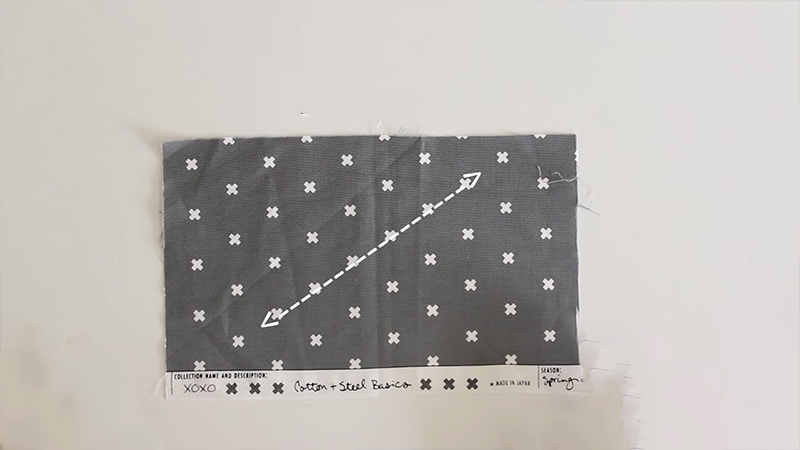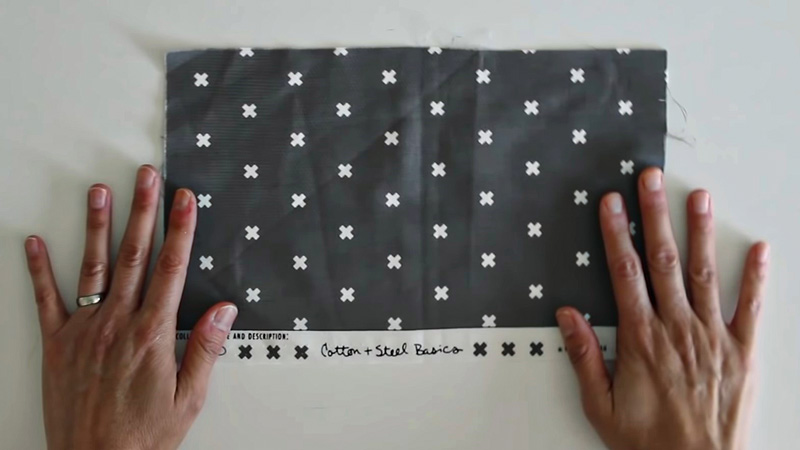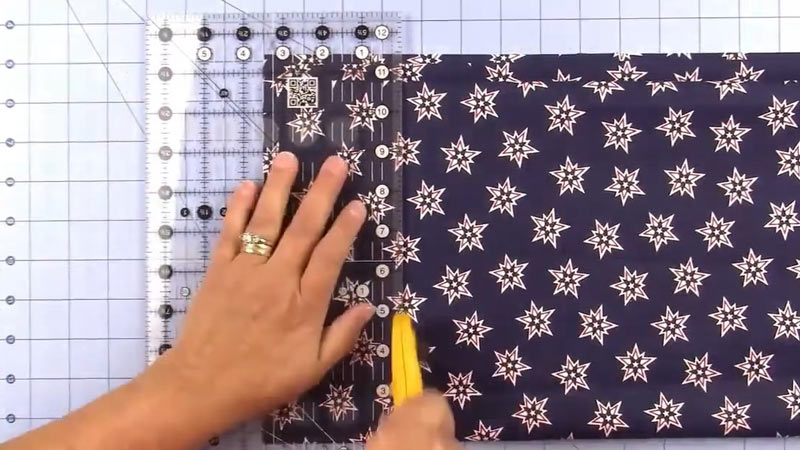In sewing, understanding the intricacies of fabric is like unlocking the secret language of textiles. One fundamental aspect that every sewing enthusiast must grasp is the concept of the crosswise grain.
This term defines the horizontal direction of the fabric, running perpendicular to the selvage edges. The crosswise grain isn’t merely a matter of orientation; it holds the key to a successful sewing project. It dictates the stretch, drape, and overall behavior of the fabric.
Whether you’re striving for a snug fit, exploring creative design possibilities, or seeking stability in your creations, comprehending the crosswise grain is a pivotal skill that will elevate your sewing expertise.

What Is Crosswise Grain in Sewing Fabric?
In sewing, the term “crosswise grain” refers to the direction of the fabric that runs perpendicular to the selvage edge or the lengthwise grain.
Understanding the crosswise grain is essential for properly cutting and working with fabric, as it can affect the drape, stretch, and overall appearance of your sewing project.
Here are some key points to help you grasp the concept of crosswise grain in sewing:
Direction
The crosswise grain runs horizontally across the width of the fabric. Imagine spreading the fabric out in front of you, with the selvage edges on either side. The crosswise grain runs from selvage to selvage, perpendicular to the selvage edges.
Stretch
Fabrics typically have more stretch along the crosswise grain compared to the lengthwise grain. This makes it an important consideration when choosing which direction to cut your pattern pieces, especially when dealing with stretchy or knit fabrics.
For garments that need to accommodate body curves or movements, cutting along the crosswise grain can provide a better fit and comfort.
Bias
The crosswise grain is also closely related to the bias of the fabric. The bias is a diagonal direction that runs at a 45-degree angle to both the lengthwise and crosswise grains.
When you cut fabric on the bias, it can result in a garment with more drape and flexibility, as well as a unique look due to the diagonal grain lines.
Stabilization
In some sewing projects, you may need to stabilize or reinforce the crosswise grain, especially when working with lightweight or slippery fabrics.
You can use techniques like staystitching, interfacing, or bias binding to prevent stretching and distortion along the crosswise grain.
Pattern Layout
When laying out your pattern pieces on the fabric, it’s important to pay attention to the grainlines indicated on the pattern.
These lines will guide you in aligning your pattern pieces correctly with the fabric’s grain. Patterns are often designed with specific grainline instructions to ensure that the garment hangs and fits properly.
Aesthetics
Depending on your project and design preferences, you may choose to feature the crosswise grain as a design element.
Placing the crosswise grain in different orientations can create interesting visual effects and textures in your sewing projects.
What Is Crosswise Grain in Sewing Clothes?

In sewing clothes, the crosswise grain refers to the direction of the fabric that runs horizontally across the width of the fabric, perpendicular to the selvage edges.
This grain direction is crucial to understand when working on sewing projects, as it plays a significant role in the fit, stretch, and overall appearance of the garment.
Here’s a closer look at the crosswise grain in sewing clothes:
Direction
The crosswise grain runs from one selvage edge to the other, forming a horizontal line across the fabric. It is at a right angle (90 degrees) to the selvage, which runs parallel to the fabric’s length.
Stretch
Fabrics typically have more stretch along the crosswise grain compared to the lengthwise grain.
This makes it an essential consideration when working with fabrics that require flexibility and comfort, such as knits or garments that need to accommodate body curves.
Pattern Alignment
When using sewing patterns, designers often indicate specific grainlines on the pattern pieces. These grainlines guide you in positioning the pattern on the fabric correctly.
Aligning the pattern with the crosswise grain may be necessary for certain pattern pieces to ensure a proper fit and drape.
Applications
The crosswise grain is commonly used for sewing elements that require stretch and flexibility. This includes areas like cuffs, waistbands, neckbands, and sleeves, where the ability to move and stretch with the body is essential.
Bias Cut
The crosswise grain is related to the bias of the fabric, which is a 45-degree angle to both the crosswise and lengthwise grains.
Cutting along the bias creates a unique drape and can be used for making garments with a more fluid, draped look. It’s often employed for eveningwear and garments with flowing silhouettes.
Stabilization
In some cases, you may need to stabilize the crosswise grain, especially when working with lightweight or slippery fabrics.
Techniques like staystitching or using interfacing can help prevent stretching and distortion along this grain.
Cutting Fabric Crosswise Grain

Cutting fabric along the crosswise grain is a fundamental technique in sewing that offers various benefits and possibilities.
The crosswise grain runs horizontally across the width of the fabric, perpendicular to the selvage edges.
Understanding how to cut fabric along this direction and when to do so is crucial for achieving the desired fit, stretch, and design in your sewing projects.
Here are some key points to consider when cutting fabric along the crosswise grain:
Stretch and Comfort
Fabrics cut along the crosswise grain often exhibit more stretch than those cut along the lengthwise grain.
This stretchiness is particularly advantageous when sewing garments that need to accommodate body curves or movements, such as waistbands, cuffs, or necklines. It can enhance the comfort and flexibility of the finished piece.
Pattern Layout
When using a sewing pattern, pay close attention to the layout instructions. Pattern pieces are typically designed with specific grainline markings that indicate the recommended direction for cutting.
Follow these guidelines to ensure that your garment fits properly and drapes as intended.
Bias Cut
Cutting fabric on the crosswise grain is related to the bias cut, which involves cutting along a 45-degree angle to both the crosswise and lengthwise grains.
This technique results in a garment with a unique drape, as it allows the fabric to follow curves and contours more gracefully. Bias-cut garments can be fluid and elegant.
Stability and Support
While the crosswise grain offers stretch, it may not provide the same stability as the lengthwise grain.
For the main body of garments that require structure and support, like skirts, pants, and bodices, it’s often preferable to cut along the lengthwise grain.
Pattern Alterations
In some cases, you may choose to alter a pattern by incorporating crosswise grain elements. For example, you might create a contrast panel along the crosswise grain or add bias binding to a neckline for visual interest.
Handling and Cutting
When working with crosswise grain sections, it’s essential to handle the fabric with care during cutting.
Avoid stretching or distorting the fabric, which can lead to misshapen pieces. Using pattern weights and a rotary cutter can help maintain the fabric’s integrity.
Crosswise Grain vs. Lengthwise Grain
The crosswise grain and lengthwise grain are two fundamental aspects of fabric orientation in sewing, each with distinct characteristics and uses.
Here’s a comparison table between the two:
| Aspect | Crosswise Grain | Lengthwise Grain |
| Direction | Horizontal (perpendicular to selvage) | Vertical (parallel to selvage) |
| Stretch | Typically more stretchy | Less stretchy |
| Stability | Less stable | More stable |
| Use | Cuffs, collars, waistbands, bias tape, areas requiring flexibility | Often aligned with the pattern center, aids in draping |
| Pattern Alignment | Different directions entirely runs diagonally | Different directions entirely run diagonally |
| Bias Relationship | Related but not the same | The main body of garments provides structure |
How to Find the Grain of Fabric
Finding the grain of fabric is a fundamental skill in sewing, as it helps ensure that your sewing projects turn out well-fitted and with the desired drape.
Here are step-by-step instructions on how to find the grain of fabric:
Materials Needed:
- Fabric
- Ruler or measuring tape
- Chalk or fabric marker
- Pins
Steps:
Prepare Your Fabric
Begin by laying your fabric out on a flat, clean surface, such as a cutting mat or a table. Smooth out any wrinkles or creases to make the fabric as flat as possible.
Locate the Selvage Edges
The selvage edges are the finished edges of the fabric that run parallel to the lengthwise grain.
These edges are usually more tightly woven and may have printed information or color dots. Identify these selvage edges on your fabric.
Identify the Lengthwise Grain
To find the lengthwise grain, you need to run your hand along the fabric from selvage to selvage.
You’ll notice that one direction has less stretch, feels more stable, and drapes differently than the other. This direction is the lengthwise grain.
Mark the Lengthwise Grain
Once you’ve identified the lengthwise grain, use chalk or a fabric marker to make a light, straight line along this direction. You can make this line along the edge of the fabric or further in if needed.
Find the Crosswise Grain
The crosswise grain runs perpendicular to the lengthwise grain. It should feel stretchier when you pull on it.
To locate it, simply fold the fabric in half with the selvage edges aligned, and the line marking the lengthwise grain should be perpendicular to this fold.
Mark the Crosswise Grain
Similar to the lengthwise grain, use chalk or a fabric marker to make a light, straight line along the crosswise grain. This line should be perpendicular to the line you marked for the lengthwise grain.
Double-Check the Grain
To ensure accuracy, you can measure the distance between your grainlines at various points along the fabric to confirm that they are straight and parallel. If needed, use pins to hold the fabric in place while measuring.
Cut or Work with the Grain
Once you’ve accurately marked the lengthwise and crosswise grains, you can use these lines as references for cutting your fabric or laying out your sewing pattern. Proper grain alignment is crucial for achieving the desired fit and drape in your sewing projects.
FAQS
Can I use the crosswise grain for quilting projects?
Yes, the crosswise grain can add dimension and texture to quilting projects.
Are there any fabrics where the crosswise grain is more prominent than the lengthwise grain?
Yes, in some fabrics like knits, the crosswise grain may be more dominant due to its greater stretch.
When should I use one half crosswise grain in my sewing projects?
One-half crosswise grain is typically utilized when you need to take advantage of the fabric’s crosswise stretch but want to maintain some stability.
How can I identify the lengthwise grain of fabric when there are no selvage edges?
In cases where the selvage edges are removed or not present, you can identify the lengthwise grain by finding the direction with the least stretch.
What is crosswise yarn called in sewing?
Crosswise yarn is called “weft” or “horizontal yarn.” This yarn runs perpendicular to the selvage edges of the fabric and plays a significant role in determining the fabric’s stretch and drape characteristics.
To Recap
In sewing, the knowledge of the crosswise grain stands as a pivotal skill. This horizontal orientation of fabric, intersecting the selvage edges, is a seamstress’s compass, guiding the way to crafting garments that fit impeccably and drape beautifully.
The crosswise grain is more than a mere thread direction; it embodies versatility. It offers stretch when needed, stability when required, and a canvas for creative exploration.
With the mastery of this grain, one can manipulate fabric to hug curves, embrace bias, and achieve bespoke designs.
The crosswise grain is an indispensable element in the art of sewing, enabling both precision and artistic expression to flourish in every stitch.
Leave a Reply